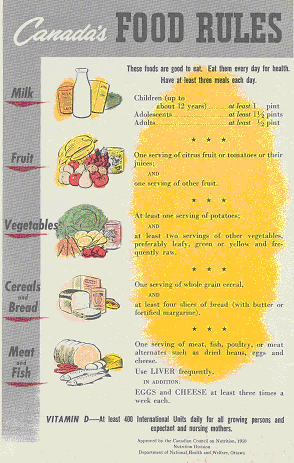Canada's Food Guide
Overview of Canada's Food Guide
Canada's Food Guide is a nutrition guide produced by Health Canada to promote healthy eating and nutritional well-being for Canadians. It provides recommendations on food choices and eating habits to support overall health.
History[edit]

The first version of Canada's Food Guide was introduced in 1942 as "Canada's Official Food Rules." It was developed during World War II to address wartime food shortages and nutritional deficiencies.
1944 Revision[edit]

In 1944, the guide was revised to reflect new nutritional knowledge and to continue addressing the needs of Canadians during the war.
1949 Revision[edit]

The 1949 revision of the guide was part of a post-war effort to improve the health of Canadians. It emphasized the importance of a balanced diet and introduced the concept of food groups.
1961 Revision[edit]
The 1961 version of the guide continued to evolve, incorporating new scientific research and dietary recommendations. It further refined the food groups and serving sizes.
Modern Versions[edit]
The guide has undergone several updates to reflect changes in nutritional science and public health priorities. The 2007 version introduced a more detailed approach to food choices and portion sizes.
2019 Revision[edit]
The most recent version, released in 2019, emphasizes a more holistic approach to eating. It encourages Canadians to focus on whole foods, plant-based diets, and mindful eating practices. The guide also highlights the importance of cooking more often and eating meals with others.
Key Recommendations[edit]
The 2019 guide provides several key recommendations:
- Eat plenty of vegetables and fruits, whole grains, and protein foods.
- Choose protein foods that come from plants more often.
- Limit highly processed foods.
- Make water your drink of choice.
- Use food labels to make informed choices.
- Be mindful of your eating habits.
- Cook more often and enjoy your food.
- Eat meals with others.
Related Pages[edit]
Ad. Transform your life with W8MD's Budget GLP-1 injections from $75


W8MD offers a medical weight loss program to lose weight in Philadelphia. Our physician-supervised medical weight loss provides:
- Weight loss injections in NYC (generic and brand names):
- Zepbound / Mounjaro, Wegovy / Ozempic, Saxenda
- Most insurances accepted or discounted self-pay rates. We will obtain insurance prior authorizations if needed.
- Generic GLP1 weight loss injections from $75 for the starting dose.
- Also offer prescription weight loss medications including Phentermine, Qsymia, Diethylpropion, Contrave etc.
NYC weight loss doctor appointmentsNYC weight loss doctor appointments
Start your NYC weight loss journey today at our NYC medical weight loss and Philadelphia medical weight loss clinics.
- Call 718-946-5500 to lose weight in NYC or for medical weight loss in Philadelphia 215-676-2334.
- Tags:NYC medical weight loss, Philadelphia lose weight Zepbound NYC, Budget GLP1 weight loss injections, Wegovy Philadelphia, Wegovy NYC, Philadelphia medical weight loss, Brookly weight loss and Wegovy NYC
|
WikiMD's Wellness Encyclopedia |
| Let Food Be Thy Medicine Medicine Thy Food - Hippocrates |
Medical Disclaimer: WikiMD is not a substitute for professional medical advice. The information on WikiMD is provided as an information resource only, may be incorrect, outdated or misleading, and is not to be used or relied on for any diagnostic or treatment purposes. Please consult your health care provider before making any healthcare decisions or for guidance about a specific medical condition. WikiMD expressly disclaims responsibility, and shall have no liability, for any damages, loss, injury, or liability whatsoever suffered as a result of your reliance on the information contained in this site. By visiting this site you agree to the foregoing terms and conditions, which may from time to time be changed or supplemented by WikiMD. If you do not agree to the foregoing terms and conditions, you should not enter or use this site. See full disclaimer.
Credits:Most images are courtesy of Wikimedia commons, and templates, categories Wikipedia, licensed under CC BY SA or similar.
Translate this page: - East Asian
中文,
日本,
한국어,
South Asian
हिन्दी,
தமிழ்,
తెలుగు,
Urdu,
ಕನ್ನಡ,
Southeast Asian
Indonesian,
Vietnamese,
Thai,
မြန်မာဘာသာ,
বাংলা
European
español,
Deutsch,
français,
Greek,
português do Brasil,
polski,
română,
русский,
Nederlands,
norsk,
svenska,
suomi,
Italian
Middle Eastern & African
عربى,
Turkish,
Persian,
Hebrew,
Afrikaans,
isiZulu,
Kiswahili,
Other
Bulgarian,
Hungarian,
Czech,
Swedish,
മലയാളം,
मराठी,
ਪੰਜਾਬੀ,
ગુજરાતી,
Portuguese,
Ukrainian